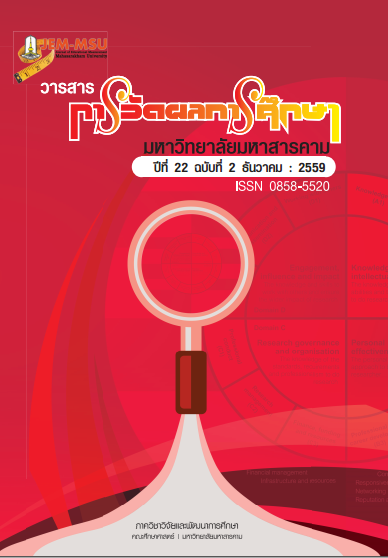Stress And Structure Model Of Male Homosexual Students
Main Article Content
Abstract
This study purposed to 1) investigate male homosexual students’ stress and
developing stress structure model, and 2) examine construct validity of the male homosexual
students’ stress model. A snowball technique was used to recruit 416 male homosexual
students studying in the academic year 2010 at institutions of higher education in the
northeastern region of Thailand. The instrument used was a questionnaire eliciting data concerning stress with discrimination (t) ranging between 5.15 to 8.51 (p<.01) and a reliability
of .91. The collected data were analyzed through descriptive statistics and the confirmatory
factors were analyzed. Results revealed that male homosexual students showed stress, as a
whole, in a moderate level. The confirmatory factor analyses of stress model revealed 3
factors, namely depressive factor consisted of 5 aspects including feeling of inferiority, lonely,
lament, committing suicide, and despair. The anxiety factor consisted of 5 aspects including
feeling fear, jittery, impatient, restless, and terrorized. The hostility factor consisted of 5
aspects including feeling moody, cross, agitated, hassle, and pernicious. The results of
secondary order confirmatory factor analyses revealed that depressive factor was the most
important by factor loading ranking. The validation of a goodness of fitted model yielded Chi
Square goodness of fit = 156.94, (p = .0510), df = 105, χ2/df = 1.49, GFI =.98, AGFI =.97, CFI =
.99, RMR = .03 and RMSEA = .03 and significances between all variables and factors of model
supported on the theoretical based.
Article Details
The content and information contained in the published article in the Journal of Educational Measurement Mahasarakham University represent the opinions and responsibilities of the authors directly. The editorial board of the journal is not necessarily in agreement with or responsible for any of the content.
The articles, data, content, images, etc. that have been published in the Journal of Educational Measurement Mahasarakham University are copyrighted by the journal. If any individual or organization wishes to reproduce or perform any actions involving the entirety or any part of the content, they must obtain written permission from the Journal of Educational Measurement Mahasarakham University.


